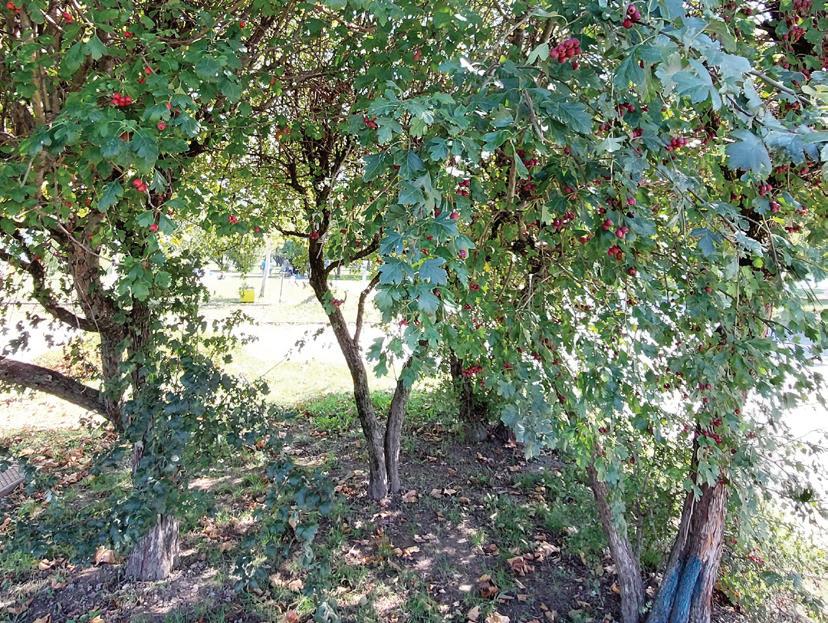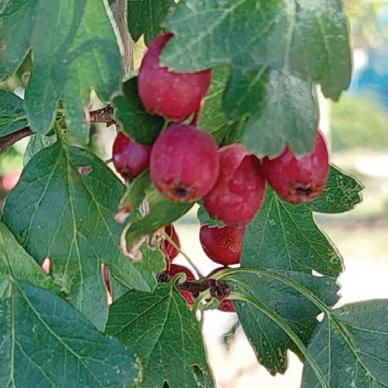
3 minute read
medicinal plants photo herbarium Hawthorn (Crataegusoxyacantha)
from NMC15 March/April
by dar-mell.com
A deciduous, thorny shrub or small tree from the Rosaceae family, hawthorn is known for its medicinal properties and long history of use in herbal medicine. This resilient plant contains flavonoids and other bioactive compounds that contribute to its therapeutic effects, particularly in improving heart function and circulation.
Botanical description
Crataegus oxyacantha , commonly known as Hawthorn, is a deciduous, thorny shrub or small tree belonging to the Rosaceae family. It typically grows 5-10 meters in height and features deeply lobed, dark green leaves. The plant produces small, fragrant white or pink flowers in clusters during late spring. These flowers develop into bright red, berry-like fruits known as haws, which persist into winter.
Hawthorn is recognized for its dense, spiny branches, which provide shelter and food for wildlife. The tree thrives in temperate regions, particularly in Europe, North America, and Asia.
Habitat & cultivation
Hawthorn is commonly found in hedgerows, woodlands, and open fields. It thrives in well-drained, loamy soils and prefers full sun to partial shade. This hardy plant can tolerate a wide range of environmental conditions, including drought and cold temperatures, making it a resilient species in various climates.
Hawthorn is often used in ornamental landscaping, as well as for conservation purposes, such as soil stabilization and wildlife habitat enhancement.
Use for medicinal purposes
Hawthorn has been traditionally used for its cardiovascular benefits. The plant contains flavonoids and other bioactive compounds that contribute to its therapeutic effects, particularly in improving heart function and circulation.
Traditional medicinal uses
Hawthorn has been used in herbal medicine for centuries. Common applications include: supporting heart health and regulating blood pressure, treating mild heart failure, angina, and arrhythmias, aiding digestion and relieving mild gastrointestinal discomfort and acting as a mild sedative to reduce stress and anxiety.
Constituents
Flavonoids (e.g., quercetin, rutin)
• Procyanidins
• Triterpenic acids
• Phenolic acids
• Amine compounds (e.g., trimethylamine)
Vitamin C
Action and application
The bioactive compounds in Hawthorn are known for their cardioprotective effects. They enhance coronary artery blood flow, improve oxygen utilization in the heart, and help maintain normal blood pressure levels. Hawthorn extracts are widely used in modern herbal medicine as a natural remedy for heart conditions.
Additionally, Hawthorn’s antioxidant properties protect cells from oxidative stress, while its mild sedative effects make it beneficial for anxiety and nervous tension.
Caution
While generally safe, Hawthorn should be used with caution in combination with prescription medications for heart conditions, as it may enhance their effects. Consulting a healthcare provider before use is recommended. Possible side effects include mild dizziness, nausea, or gastrointestinal discomfort in sensitive individuals. There isn't enough reliable information to know if hawthorn is safe when used for longer than 16 weeks. Hawthorn is usually well-tolerated.
References: https://www.webmd.com/vitamins/ai/ingredientmono-527/hawthorn
Dahmer S, Scott E. Health effects of hawthorn. Am Fam Physician. 2010;81(4):465-468.

TAXONOMY kingdom: Plantae order: Rosales family: Rosaceae genus: Crataegus species: Crataegus oxyacantha
COMMON NAME
Hawthorn, May Tre, Quickthorn, White Thorn, Aubépine (French)
FLOWERING TIME IV–VI month


